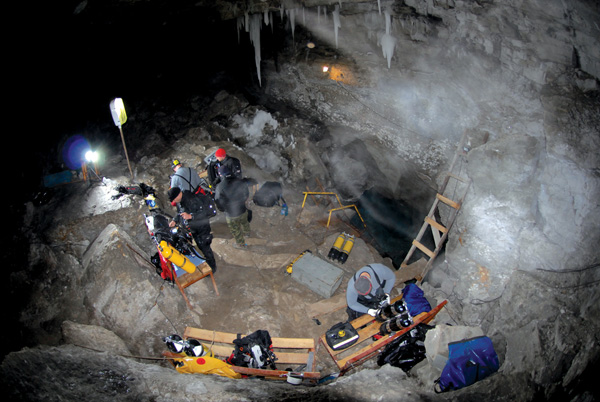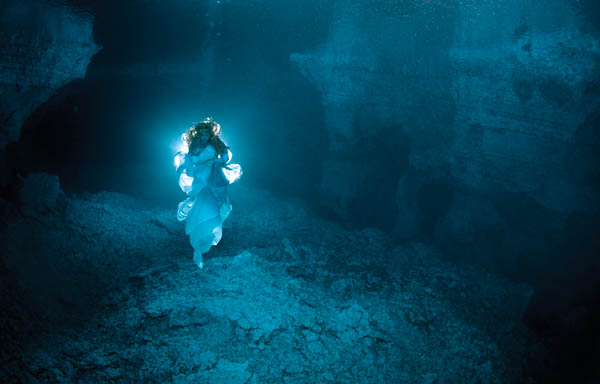The Cave That Changed The Game In Russia
Extending more than three miles (5km) in length, it is the longest known gypsum cave on the planet, most of it underwater. In Eurasia it’s the second longest cave, after the Doux de Coly in the Dordogne region of southwest France. And in Russia itself, Orda is the longest cave. Of all the known cave systems in the world’s largest country, nothing exceeds it in length.
It’s located southeast of the village of Orda in the Perm region, on the Russian Plain where the land rises into the eastern foothills of the Ural Mountains. Above ground its appearance is unremarkable: a grassy hill not more than 165 feet (50m) high with a flat top. A river surrounds this rise, which is peppered with sinkholes, one of which on the south slope provides access to the amazing vistas that lie underground and underwater.
The gypsum deposits here were discovered in the early 19th century and used in the construction industry. This mineral occurs in nature in transparent crystalline masses called selenite, a word derived from the ancient Greek for ‘moon’, which explains why it’s also referred to as moonstone. By the end of that century, selenite was at the centre of the stone cutting trade in the region. Craftsmen skilled at showcasing its beauty processed enough for export to 26 countries during peak production years.
Today, the cave’s monumental white gypsum interiors are pure and light, the water is crystal clear and the many passages are a joy to explore. But it’s cold and and capricious. Water temperatures range from a high of about 40℉ (5℃) and can get cooler. Where limestone caves are more typical, Orda is formed by gypsum and anhydrite rocks, both of which are highly soluble in water, which results in structural change over time. As new passages form, others become blocked; geologically the cave has never stopped rearranging itself through the millennia. In spite of it all, the beauty of the Orda Cave continues to wow the well-traveled cave diver, celebrities included, with its cathedral-like galleries, passageways and enduring promise of discovery.

Geological Story
These rocks appeared almost 300 million years ago in the Permian age, the last period of what we call the Paleozoic era, a time of dramatic geological, climatic and evolutionary change. The era ended with the Permian-Triassic extinction event that, scientists say, was the largest mass extinction in Earth’s history. At that time sea covered the land to the east and south of the Ural Mountains.
Then geological activity deepened river valleys, heaved up the land and as this shifting and shaking occurred, cracks formed in the gypsum and other rock, running from tens to hundreds of metres deep into the Earth’s crust. These tectonic tears are visible along river valleys and ravines and permit water to penetrate and diminish soluble rock, leading to formation of karst topography, a landscape pocked with sinkholes that spiral into the subterranean world.
Over long periods of time, vast underground galleries were carved out by this process and, inevitably, some of these cavernous formations collapsed. Today, divers can see the bottom of Orda Cave galleries are covered in ‘scree’, the broken rock fragments from age old geological events. Sometimes a collapse causes a hole to break the surface above, one of which became the cave entrance when it opened up in the early 1970s.

Until Orda was discovered by schoolboys, who found the small entranceway at the bottom of a pit, nothing even remotely close to this cave was known to exist in Russia. There are numerous ‘siphons’ in places such as Crimea, the Caucasus region, the Ural Mountains, Bashkiria and Siberia, but none extend more than 300 plus feet (100m). Typically they are narrow and muddy. Some bigger siphons exist and have been explored as well, but visibility is uniformly poor.
Diving these involved a high level of risk and so only the most skilled cave divers ventured into them, typically solo, fastened to a guideline, proceeding with extreme caution. To navigate the narrow, almost zero vis passages, they customized open and closed circuit underwater breathing apparatus. In those days the objective most often was to follow a dry passage, then swim through the siphon to where the dry passage continued. Achieving this was considered success. It was the way of cave diving in the Soviet era.

After Orda
In 1993, Andrey Samovolnikov, a cave diver from the Perm region explored areas of the dry cave and, having reported his experience to Igor Lavrov, a researcher at the Kungur Station of the Russian Academy of Sciences, an expedition was mounted later the same year. Size of the Orda Cave amazed everyone and it was the following year, in March, that an experienced cave diver from Ryazan, Victor Komarov, slipped into Orda’s chilly water and explored the first 300 plus feet (100m), leading the way for much more extensive explorations in the years since.
Cave divers aren’t the only explorers of Orda’s sunless world. Plenty of speleologists have descended into its dark recesses. Their gear and techniques are different, and their agendas, too; but they all return impressed and over the years this collection of wet and dry cave enthusiasts have penetrated and prodded and produced a great deal of research data. Today there are detailed maps and high resolution images readily accessible for the scientist or the simply curious.
This underwater ‘roadmap’ in tandem with exceptional visibility and easy access makes Orda a ‘go to’ cave diving destination in Russia and more widely, Eurasia, given its proximity to these bordering regions of the world. For training, workshops and just pure fun, Orda is now high on the wish list of cave divers across the sport’s experience spectrum.
The great visibility in this cave, typically 130 to 165 feet (40-50m), makes buddy diving easy and also makes it unnecessary to be physically connected to a buddy or even to be fastened to a guideline. By the late 1990s imported cave diving gear was readily available and affordable. Suits, thermal garments, BCDs, powerful lighting systems – all were accessible and made possible lengthy excursions into the cave.
Over the years cave diving has changed in other ways in this part of the world. Where a cave expedition once involved as many as 20 or 30 people, today the sport is enjoyed by smaller groups. And where those big expeditions would take place over a month, today’s cave divers are making more trips per year for shorter periods of time, regardless of the season or geographical area. It’s almost as if Orda’s expansive galleries opened the door to usher in an expansive new way to view and practice the sport.
Since 2000 the Orda cave has become a magnet for cave divers and speleologists across the country. It’s not a stretch to say that the impact of this relatively new found cave system sparked change as dramatic in its own way as the events of 1991 were revolutionary in the history of the Russian Federation.


Learn More:
A bilingual Russian/English book is available on the Orda Cave. For more information send inquires to info@phototeam.pro
One Response to “The Cave That Changed The Game In Russia”
Leave a Comment








Brandon Athey
This is incredible. I would love to get myself into this cave and do some photography. There are so many options for setting up a good scenario in this exotic cave!